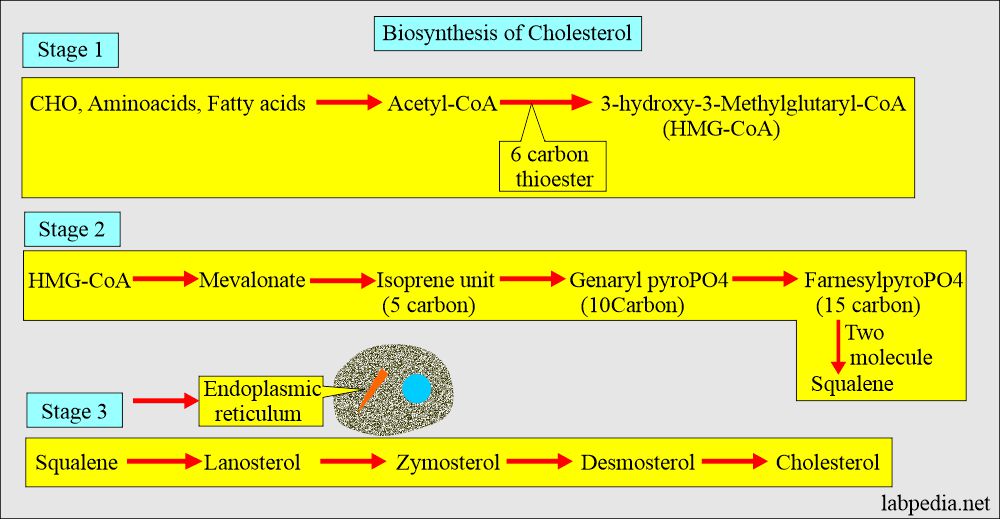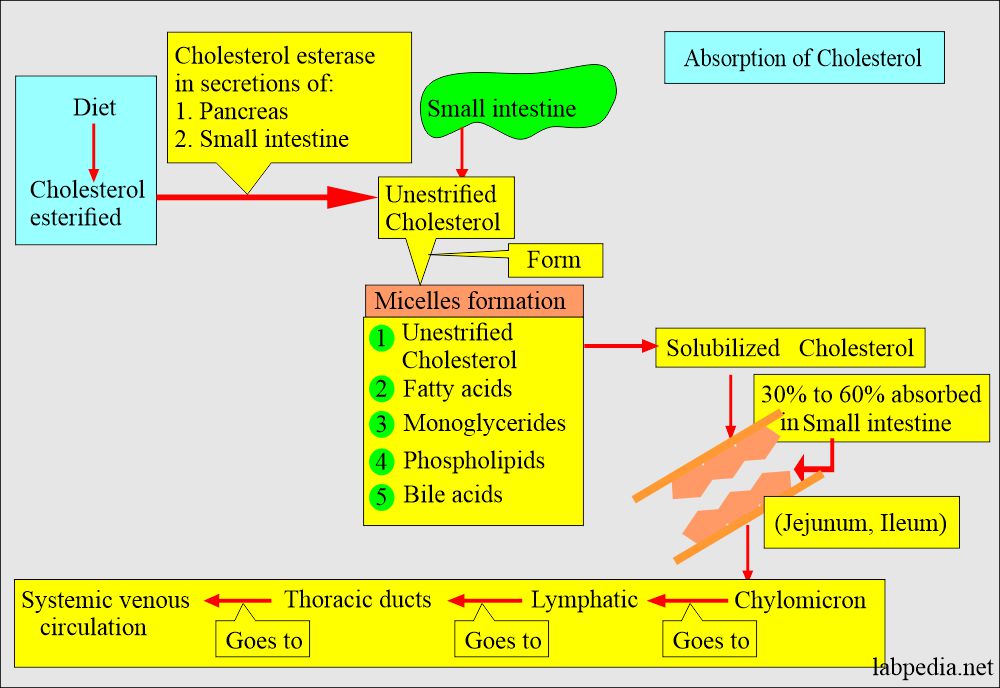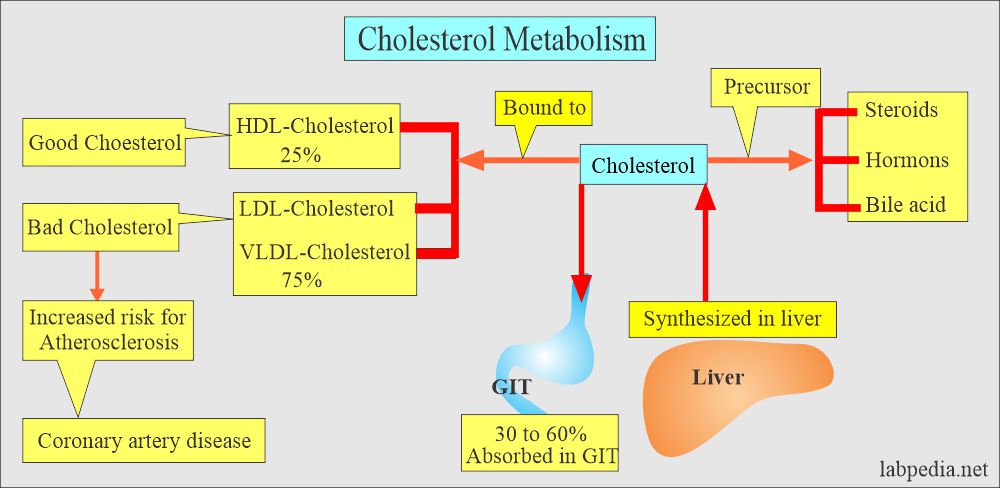How to control Cholesterol
How to control Cholesterol
- Scottish have the highest rate of cardiovascular disease because they don’t eat vegetables. Americans are behind the Scottish because they eat hamburgers.
What are the complications of High cholesterol?
- It is the main risk factor for cardiovascular diseases, stroke, and other vascular diseases.
- When you lower cholesterol by 1%, the chance of a heart attack is lowered by 2%.
What are the benefits of cholesterol?
- Cholesterol is essential for so many physiologic functions.
- Cholesterol is an important part of the cell membranes.
- Cholesterol acts as the precursor for the synthesis of steroids.
- Cholesterol is a precursor for the synthesis of vitamin D.
- Cholesterol is converted into bile acids in the liver.
- Cholesterol is important for brain function and development.
Where is the Synthesis site of cholesterol?
- Cholesterol is produced in the liver.
- It is essential for:
- Cell membrane.
- Sex hormones.
- Bile acid.
- Vitamin D.
- Life is impossible without cholesterol, so it is essential for the body.
What foods show the presence of cholesterol?
- Milk.
- Butter.
- Eggs.
- Meat.
How would you describe the metabolism of cholesterol?
- Cholesterol gives rise to bad cholesterol LDL-cholesterol, which blocks the blood vessels.
- HDL-cholesterol transports the bad cholesterol (LDL-cholesterol) out of the blood to the liver for disposal.
- When HDL cholesterol decreases and can not remove the bad cholesterol, the LDL cholesterol level will increase to a dangerous level.
What are the recommendations of the National Cholesterol Education Program?
- Keep the total cholesterol level below 200 mg/dL.
- LDL should be below 130 mg/dL.
- HDL needs to be above 65 mg/dL.
- To control and keep cholesterol within a limit, do not eat more than 300 mg of cholesterol in your diet daily (little more than 1.5 egg yolk).
- A diet rich in vegetables, fruits, and grains is low in red meats and dairy products and is nearly perfect for lowering cholesterol.
- A low-fat vegetarian diet leads to a drop in total cholesterol of 24%.
What are the Saturated fats:?
- The biggest component of food that affects blood cholesterol is saturated fats.
- saturated fats are found in red meats, whole, and 2% milk, egg yolk, butter, and cheese, increasing the LDL and total cholesterol levels in the blood.
- The daily value for fat is 30% of the total calories. It is much better if calories from fat are lowered to 25% and not more than 7% from saturated fats.
- The American diet:
- It contains cheese, milk, red meat, and convenience foods. Reducing saturated fats can help lower cholesterol.
- Replacing hamburgers with fish twice weekly will save you from eating 4 pounds of fat yearly.
- Saturated fats in animal foods create more problems.
- American Heart Association limits 5 to 8 teaspoons of oil.
- Milk with full fat can dump more fat in your body. Try to use 1% or skimmed milk and low-fat yogurt.
- Eating more fruits and vegetables is the best way to eat less fat. These foods contain minerals and vitamins, help to fill you up so that you eat less of other foods, and also contain more fiber.
What are the Monounsaturated fats?
- The monounsaturated fat in avocado and olive oil can lower bad cholesterol (LDL-cholesterol) without affecting HDL-cholesterol.
- Countries like Spain, Greece, and other Mediterranean countries where olive oil is used routinely have a lower rate of heart attacks.
- Olive oil improves the liver’s ability to remove the LDL-cholesterol from the blood circulation.
- People in Mediterranean countries eat more fresh fruits and vegetables than Americans and are less likely to be overweight. Try to use olive oil in moderation.
What is the role of Fibers in the diet?
- Food rich in fibers, such as beans, whole grains, and fresh fruits, will keep your digestive system in shape and reduce the cholesterol level in your blood.
- The soluble fibers form the gummy gel in the digestive tract, which will lower the cholesterol level.
- The cholesterol level is lower in the people eating oats 3 ounces per day, and they have 11% lower blood pressure than the people who rarely eat oats. The blood pressure is also lower in those who eat oats, around 8%.
- The high-fiber diet has a beneficial effect on lowering cholesterol and blood pressure.
- A high-fiber diet can reduce the death rate from cardiovascular diseases.
- There were two groups: one was eating 15 grams of fiber, and others were eating 35 grams of fiber. After a year, people on high-fiber diets dropped 13% of cholesterol.
- The daily value for fiber is 25 grams.
- The daily requirement is eating 2 to 4 servings of fruits, 3 to 5 servings of vegetables, and 6 to 11 servings of bread, cereals, and grains daily.
- Eating oatmeal and oat bran cereals several times a week adds more soluble fiber to your diet.
- Other sources of soluble fiber are pinto beans, red kidney beans, sweet potatoes, and Brussels sprouts.
What is the role of Garlic in diet?
- It is believed that garlic can significantly lower the cholesterol level.
- Garlic contains a chemical called allicin, which controls the body’s use of cholesterol.
- Eating clove and the Garlic daily lowers the cholesterol an average 9%.
- The best way to use garlic is to mince or crush garlic, which will release more allicin.
What is the role of Fish and omega-3?
- Salmon and tuna fish contain omega-3 fatty acids, lowering triglyceride levels.
- Men taking fish 3 to 5 ounces per day will have a drop in cholesterol.
- Omega-3 lowers triglycerides and increases the HDL-cholesterol.
- Fish is low in calories and saturated fats, perfect as cholesterol-reducing food.
- Eating 3 to 4 ounces of fish per week will give maximum benefits to the omega-3 diet.
- Try to buy Tuna packed in water; this will have 111 calories and <1 gram of fats. The tuna in oil contains 168 calories and nearly 7 grams of fat.
How can you control high Cholesterol?
- High Cholesterol can be controlled by a healthy lifestyle like:
- Diet.
- Exercise.
- Avoidance of smoking.
- Avoidance of excessive use of alcohol.



